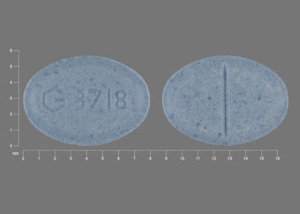Triazolam and Alcohol/Food Interactions
There are 2 alcohol/food/lifestyle interactions with triazolam.
Triazolam Food/Lifestyle
Moderate Food Interaction
GENERALLY AVOID: The pharmacologic activity of oral midazolam, triazolam, and alprazolam may be increased if taken after drinking grapefruit juice. The proposed mechanism is CYP450 3A4 enzyme inhibition. In addition, acute alcohol ingestion may potentiate CNS depression and other CNS effects of many benzodiazepines. Tolerance may develop with chronic ethanol use. The mechanism may be decreased clearance of the benzodiazepines because of CYP450 hepatic enzyme inhibition. Also, it has been suggested that the cognitive deficits induced by benzodiazepines may be increased in patients who chronically consume large amounts of alcohol.
MANAGEMENT: The manufacturer recommends that grapefruit juice should not be taken with oral midazolam. Patients taking triazolam or alprazolam should be monitored for excessive sedation. Alternatively, the patient could consume orange juice which does not interact with these drugs. Patients should be advised to avoid alcohol during benzodiazepine therapy.
References (7)
- (2002) "Product Information. Xanax (alprazolam)." Pharmacia and Upjohn
- (2002) "Product Information. Valium (diazepam)." Roche Laboratories
- (2001) "Product Information. Halcion (triazolam)." Pharmacia and Upjohn
- (1995) "Grapefruit juice interactions with drugs." Med Lett Drugs Ther, 37, p. 73-4
- Kupferschmidt HHT, Ha HR, Ziegler WH, Meier PJ, Krahenbuhl S (1995) "Interaction between grapefruit juice and midazolam in humans." Clin Pharmacol Ther, 58, p. 20-8
- Hukkinen SK, Varhe A, Olkkola KT, Neuvonen PJ (1995) "Plasma concentrations of triazolam are increased by concomitant ingestion of grapefruit juice." Clin Pharmacol Ther, 58, p. 127-31
- Bailey DG, Dresser GR, Kreeft JH, Munoz C, Freeman DJ, Bend JR (2000) "Grapefruit-felodipine interaction: Effect of unprocessed fruit and probable active ingredients." Clin Pharmacol Ther, 68, p. 468-77
Switch to consumer interaction data
Triazolam Obesity
Moderate Potential Hazard, Moderate plausibility
benzodiazepines - obesity
The plasma half-lives of benzodiazepines may be prolonged in obese patients, presumably due to increased distribution into fat. Marked increases in distribution (> 100%) have been reported for diazepam and midazolam, and moderate increases (25% to 100%) for alprazolam, lorazepam, and oxazepam. Therapy with benzodiazepines should be administered cautiously in obese patients, with careful monitoring of CNS status. Longer dosing intervals may be appropriate. When dosing by weight, loading doses should be based on actual body weight, while maintenance dose should be based on ideal body weight to avoid toxicity.
References (14)
- (2002) "Product Information. Xanax (alprazolam)." Pharmacia and Upjohn
- (2002) "Product Information. Valium (diazepam)." Roche Laboratories
- (2002) "Product Information. Ativan (lorazepam)." Wyeth-Ayerst Laboratories
- (2001) "Product Information. Serax (oxazepam)." Wyeth-Ayerst Laboratories
- (2001) "Product Information. Restoril (temazepam)." Sandoz Pharmaceuticals Corporation
- (2001) "Product Information. Halcion (triazolam)." Pharmacia and Upjohn
- (2001) "Product Information. Dalmane (flurazepam)." Roche Laboratories
- (2001) "Product Information. Tranxene (clorazepate)." Abbott Pharmaceutical
- (2001) "Product Information. Klonopin (clonazepam)." Roche Laboratories
- (2022) "Product Information. Prosom (estazolam)." Abbott Pharmaceutical
- (2001) "Product Information. Librium (chlordiazepoxide)." Roche Laboratories
- (2001) "Product Information. Doral (quazepam)." Wallace Laboratories
- (2001) "Product Information. Versed (midazolam)." Roche Laboratories
- American Medical Association, Division of Drugs and Toxicology (1994) "Drug evaluations annual 1994." Chicago, IL: American Medical Association;
Switch to consumer interaction data
Triazolam drug interactions
There are 560 drug interactions with triazolam.
Triazolam disease interactions
There are 9 disease interactions with triazolam which include:
- acute alcohol intoxication
- closed-angle glaucoma
- drug dependence
- renal/liver disease
- respiratory depression
- seizures
- depression
- obesity
- paradoxical reactions
More about triazolam
- triazolam consumer information
- Check interactions
- Compare alternatives
- Pricing & coupons
- Reviews (77)
- Drug images
- Latest FDA alerts (2)
- Side effects
- Dosage information
- During pregnancy
- Drug class: benzodiazepines
- Breastfeeding
- En español
Related treatment guides
Drug Interaction Classification
| Highly clinically significant. Avoid combinations; the risk of the interaction outweighs the benefit. | |
| Moderately clinically significant. Usually avoid combinations; use it only under special circumstances. | |
| Minimally clinically significant. Minimize risk; assess risk and consider an alternative drug, take steps to circumvent the interaction risk and/or institute a monitoring plan. | |
| No interaction information available. |
See also:
Further information
Always consult your healthcare provider to ensure the information displayed on this page applies to your personal circumstances.


